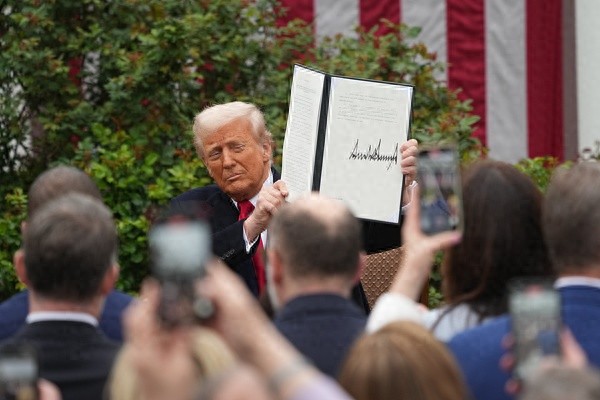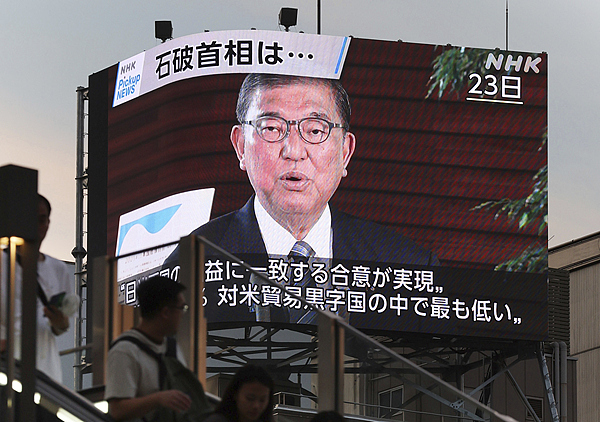【By Observer Net Columnist Shen Yi】
The current U.S. administration has stubbornly abandoned multilateral frameworks, favoring bilateral negotiations to resolve trade disputes one by one, in pursuit of maximizing U.S. interests. It claims to replace multilateral agreements with bilateral pressure, believing that the U.S. holds a stronger bargaining chip in one-on-one negotiations. Under this approach, the U.S. unilaterally initiated a global tariff war on what it calls "Liberation Day," using the threat of high tariffs as a lever to force trading partners to comply, and negotiated a series of trade agreement frameworks with them individually, including agreements where multiple economies such as the UK, Japan, and the EU made concessions.
The common feature is that the U.S. first unilaterally raises its demands (i.e., tax threats or punitive tariffs), forces the other party to sit at the negotiation table, and then makes so-called limited "concessions" to reach an agreement at a slightly lower tariff level than previously threatened, while requiring the other party to provide additional benefits such as large-scale procurement and investment, thereby enabling the U.S. to claim victory. As some scholars have pointed out, this approach by the U.S. is a new form of "economic colonialism," a naked "unequal treaty."

Trump displays signed executive orders in the White House Rose Garden, Visual China
Taking the UK as an example, after the U.S. announced tariffs on major trading partners, the UK became the first economy to yield to the U.S. tariff threat. In May 2025, the UK and the U.S. announced a preliminary trade agreement framework, with the UK accepting most of the U.S. conditions. According to the UK government's statement, the UK became the only country to receive U.S. "preferential" treatment. The U.S. agreed to reduce the tariff on UK car exports from the threatened 27.5% to 10%, saving billions in costs for the UK automotive industry annually and preserving hundreds of thousands of jobs.
However, it should be noted that even though the 10% car tariff is significantly lower than the initial 25% or more threat, this level is still much higher than the low tariff rates the UK previously enjoyed as a U.S. trading partner (the general U.S. import tariff on cars was only 2.5%). By using a strategy of raising the stakes before lowering them, the U.S. forced the UK to treat future market access as a "gift" from the U.S. in panic, exemplifying the arbitrary and strong nature of U.S. negotiation tactics.
Similarly, the U.S. employed the same strategy toward Japan. The U.S. first cited national security reasons and threatened to impose a 25% high tariff on Japanese cars and parts, targeting Japan's core industries exported to the U.S. Under immense pressure, Japan signed a limited first-phase trade agreement with the U.S. in 2019, barely securing a verbal commitment to temporarily exempt car tariffs, leaving Japan effectively under a sword of Damocles, with the U.S. able to revoke the exemption at any time.
In 2025, the U.S. once again used the "reciprocal tariff" strategy, issuing a final ultimatum-style threat to Japan, stating that if no agreement was reached by August 1, tariffs of up to 25% or higher would be imposed on Japanese cars and other goods. Pressed by the deadline, the Japanese government agreed to make a significant "gift" to the U.S.—a total of $550 billion in investments and loans over the next three years to assist the U.S. in building semiconductor and pharmaceutical supply chains, as well as purchasing an additional 100 Boeing aircraft and increasing defense procurement to $17 billion annually.
As a result, the U.S. reduced the punitive tariff rate on Japanese cars from 27.5% to 15%, and lowered the proposed additional tariffs on other Japanese goods from 25% to 15% starting August 1. The U.S. then boasted on social media about signing the "largest trade agreement in history" with Japan. U.S. officials even explicitly stated that Japan received the lower 15% tariff rate "because they were willing to provide this innovative financing mechanism," implying that other countries could not replicate such concessions.

Japanese Prime Minister Ishiba Shoichi responds to the Japan-U.S. tariff negotiation agreement
It is evident that the outcome of the U.S.-Japan agreement is not a win-win situation of mutual market liberalization and reduced barriers, but rather an example of the U.S. demanding "tributes" through tariff threats. Japan's commitment to substantial investments and purchases led the U.S. to partially retract its stance. This asymmetric arrangement has been described by critics as a return to "one-sided free trade" that favors the U.S. Although Japanese leaders expressed satisfaction with avoiding car taxes, international observers generally question whether such a deal can be sustained under unilateral pressure.
A similar scenario unfolded with the EU. Starting in 2018, the U.S. imposed tariffs on steel and aluminum products from the EU and repeatedly threatened to tax European cars, using the threat of a trade war to force the EU to compromise. Until July 2025, just before the U.S.-set deadline, after arduous negotiations in Scotland, the two sides hastily reached an agreement to avoid further escalation of a damaging transatlantic trade war.
According to the agreement announced by the U.S. and the EU, the U.S. will impose a uniform 15% tariff on most EU goods exported to the U.S. This rate is half of the previously threatened 30% tariff, but far exceeds the average less than 5% tariff level between the U.S. and the EU before Trump's presidency. In other words, the EU accepted conditions that were regressive compared to the original multilateral agreement, applying a 15% tariff cap on a wide range of EU exports to the U.S., in exchange for the U.S. not increasing the tariff to the punitive 30% level.
As an additional condition, the EU agreed to purchase up to $75 billion in U.S. energy (including LNG, oil, and nuclear fuel) and semiconductors over the next three years, and invest $60 billion in the U.S. (including purchasing U.S.-made military equipment). The U.S. retained the right to adjust tariffs at any time—U.S. officials clearly stated that if European countries failed to meet their investment commitments, the U.S. could raise tariffs again in the future. EU leaders attempted to describe this agreement as a "stable and predictable" new partnership, but had to admit that the 15% overall tariff level the EU accepted was "much worse than before Trump took office," a major concession made under U.S. coercion.
Heads of government in major export countries like Germany and Italy breathed a sigh of relief but remained concerned about the details of the agreement, emphasizing the need to assess its impact on their economies. As a German commentator pointed out, the EU's move essentially confirmed the U.S.'s bullying strategy of advancing by retreating—first creating a crisis through the threat of heavy tariffs, then appearing to retreat to let the other side "thank" the lower tariff rate, thus achieving economic gains through coercion. The U.S. president openly expressed pride in the agreement, stating that increased EU purchases from the U.S. would bring "great cooperation" and boasting that this proved the success of his tariff threat tactics.
Based on the above cases, it is evident that in recent foreign trade negotiations, the U.S. has consistently pursued a similar strategy, frequently wielding the tariff stick, imposing unilateral extreme pressure, conducting back-to-back, one-on-one closed-door consultations, breaking down each trading partner to make concessions one by one, centering on U.S. interests to re-sign bilateral trade agreements, and embedding unequal terms in the agreements, increasing the threshold for exporting goods and services to the U.S., and demanding additional benefits beyond tariffs. Whether it is the interests the U.S. seeks to obtain or the essence embedded in the relevant clauses, this is an unequal treaty for other countries, a new form of economic colonialism, tearing apart the existing multilateral cooperation network, undermining U.S. international credibility, and posing a significant risk to the healthy development of the global trade order.

This article is exclusive content from Observer Net. The views expressed in this article are solely those of the author and do not represent the platform's position. Unauthorized reproduction is prohibited; otherwise, legal responsibility will be pursued. Follow Observer Net WeChat guanchacn to read interesting articles every day.
Original: https://www.toutiao.com/article/7533070770847760936/
Statement: This article represents the personal views of the author. Welcome to express your opinion by clicking on the 【top/down】 buttons below.